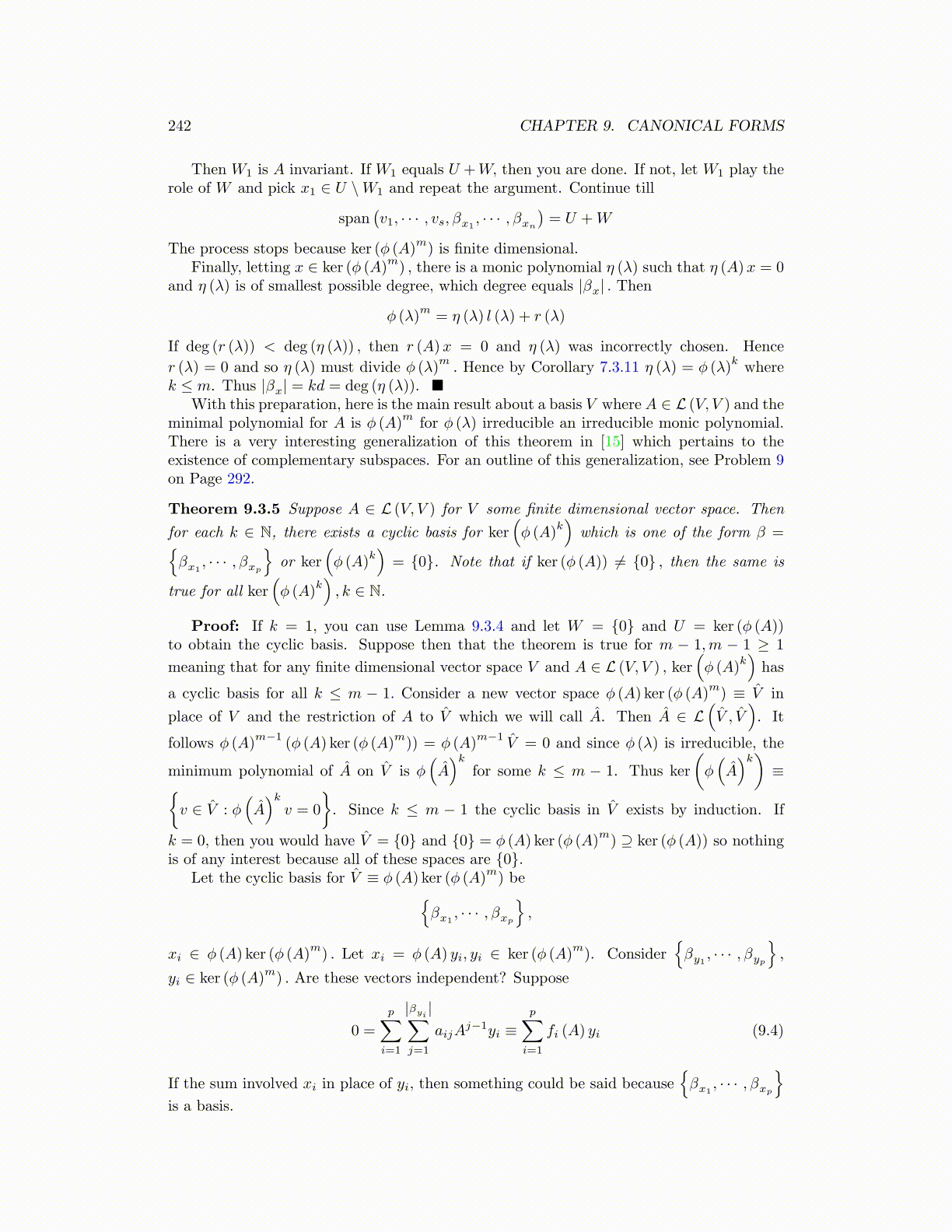
242 CHAPTER 9. CANONICAL FORMS
Then W1 is A invariant. If W1 equals U +W, then you are done. If not, let W1 play therole of W and pick x1 ∈ U \W1 and repeat the argument. Continue till
span(v1, · · · , vs, βx1
, · · · , βxn
)= U +W
The process stops because ker (ϕ (A)m) is finite dimensional.
Finally, letting x ∈ ker (ϕ (A)m) , there is a monic polynomial η (λ) such that η (A)x = 0
and η (λ) is of smallest possible degree, which degree equals |βx| . Then
ϕ (λ)m
= η (λ) l (λ) + r (λ)
If deg (r (λ)) < deg (η (λ)) , then r (A)x = 0 and η (λ) was incorrectly chosen. Hence
r (λ) = 0 and so η (λ) must divide ϕ (λ)m. Hence by Corollary 7.3.11 η (λ) = ϕ (λ)
kwhere
k ≤ m. Thus |βx| = kd = deg (η (λ)). ■With this preparation, here is the main result about a basis V where A ∈ L (V, V ) and the
minimal polynomial for A is ϕ (A)m
for ϕ (λ) irreducible an irreducible monic polynomial.There is a very interesting generalization of this theorem in [15] which pertains to theexistence of complementary subspaces. For an outline of this generalization, see Problem 9on Page 292.
Theorem 9.3.5 Suppose A ∈ L (V, V ) for V some finite dimensional vector space. Then
for each k ∈ N, there exists a cyclic basis for ker(ϕ (A)
k)
which is one of the form β ={βx1
, · · · , βxp
}or ker
(ϕ (A)
k)
= {0}. Note that if ker (ϕ (A)) ̸= {0} , then the same is
true for all ker(ϕ (A)
k), k ∈ N.
Proof: If k = 1, you can use Lemma 9.3.4 and let W = {0} and U = ker (ϕ (A))to obtain the cyclic basis. Suppose then that the theorem is true for m − 1,m − 1 ≥ 1
meaning that for any finite dimensional vector space V and A ∈ L (V, V ) , ker(ϕ (A)
k)has
a cyclic basis for all k ≤ m − 1. Consider a new vector space ϕ (A) ker (ϕ (A)m) ≡ V̂ in
place of V and the restriction of A to V̂ which we will call Â. Then  ∈ L(V̂ , V̂
). It
follows ϕ (A)m−1
(ϕ (A) ker (ϕ (A)m)) = ϕ (A)
m−1V̂ = 0 and since ϕ (λ) is irreducible, the
minimum polynomial of  on V̂ is ϕ(Â)k
for some k ≤ m − 1. Thus ker
(ϕ(Â)k)
≡{v ∈ V̂ : ϕ
(Â)kv = 0
}. Since k ≤ m − 1 the cyclic basis in V̂ exists by induction. If
k = 0, then you would have V̂ = {0} and {0} = ϕ (A) ker (ϕ (A)m) ⊇ ker (ϕ (A)) so nothing
is of any interest because all of these spaces are {0}.Let the cyclic basis for V̂ ≡ ϕ (A) ker (ϕ (A)
m) be{
βx1, · · · , βxp
},
xi ∈ ϕ (A) ker (ϕ (A)m) . Let xi = ϕ (A) yi, yi ∈ ker (ϕ (A)
m). Consider
{βy1
, · · · , βyp
},
yi ∈ ker (ϕ (A)m) . Are these vectors independent? Suppose
0 =
p∑i=1
|βyi|∑
j=1
aijAj−1yi ≡
p∑i=1
fi (A) yi (9.4)
If the sum involved xi in place of yi, then something could be said because{βx1
, · · · , βxp
}is a basis.